Suchergebnisse für "Factsheet: Energietechnologien gestalten, die für alle sinnvoll und nutzbar sind"
fit4power2heat
The integration of heat pumps can increase the cost effectiveness of existing heating networks and counter the high costs for the expansion of power grids at the same time. Aim of the project is to develop innovative business models for small and medium municipal heating networks with focus on synergies between heat and power market. Main focus is a heat pump pooling for several heat grids.
ThermoCluster - Heat generation from infrastructure projects and integration into decentralised low-temperature heating and cooling networks for plus-energy districts
Integrative assessment of the geothermal potential of the Brenner base tunnel and the northern portal area, and the subsequent distribution of the heat generated from these sources to the end-consumer in potential plus-energy districts of the city of Innsbruck.
G2G – Innovation axis Graz-Gleisdorf
Development of testbeds and demonstration zones within already designated areas for urban development along the Graz-Gleisdorf Innovation-Axis with a focus on energy, integrated building technology, smart city-spaces, compact settlement structures, generational living, and ‘cities of short ways’. It will pay specific attention to intermodal mobility as well as ICT-based solutions.
DIM4Energy - Digital Information Models for the Planning and Optimization of Buildings and Urban Energy Infrastructure
Digital information models (DIM) are playing an increasingly important role in urban planning and decision-making processes, from individual buildings (BIM) to urban information models (UIM). For the planning and optimal operation of plus-energy neighborhoods, valuable information could be obtained from these existing models, provided the appropriate data sources and associated software tools are properly linked.
CO2 neuBau - The CO2-neutral Construction Site: a Contribution to the Climate Protection by the Austrian Construction Industry
Identification of all direct and indirect CO2, respectively, GHG emissions generated at construction sites. Analysis of the framework conditions and technologies towards demonstrating the options for their control. In parallel, added values, such as cost-benefit advantages of a CO2-neutral construction site, were outlined and quantified.
VERTICAL FARMING - Investigation on requirements of a Vertical Farm-prototype development for crop plant production
In the center of interest stands the investigation of fundamental principles for a new building typology – the Vertical Farm. Urban vertical food production can contribute to more energy efficient cities by concurrently reducing land use. Substantial influencing factors to achieve these goals are intended to be revealed.
Technological as well as economical optimized Biomass CHP systems with regard to state-of-the-art technologies.
Analysis and presentation of representative biomass CHP systems with an electric power output of less than 2 MW. Variation of parameters and identification of potential optimized interactions between specific units. Identification of the economically and thermodynamically most optimized interconnection based on state-of-the-art technologies.
Future Quarter - Way to an energy-plus quarter in Vienna
Development of transferable concepts for energy-plus quarters as substantial preparatory work for the implementation of an energy showcase quarter in Vienna based on six concrete areas. The support for the broad application of the concept shall be a precursor for the realisation of future energy showcase quarters in Vienna and other cities.
Erste Passivhaus -Schulsanierung
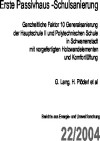
Schriftenreihe
22/2004
DI Hans-Christian Obermayr
Deutsch, 136 Seiten
Downloads zur Publikation
Monitoring Sonnenhaus Eferding

Schriftenreihe
05/2013
P.J. Sölkner, I. Hofer, B. Zettl
Herausgeber: BMVIT
Deutsch, 69 Seiten
Downloads zur Publikation
Das Ökologische Passivhaus
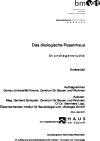
Schriftenreihe
27/2001
G. Schuster, B. Lipp
Deutsch, 174 Seiten
Downloads zur Publikation
Kriterienkatalog Plus-Energiesanierung
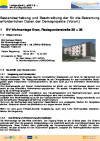
Sonja Geier, Armin Knotzer
Herausgeber: BMVIT
Deutsch, 30 Seiten
Downloads zur Publikation
Passivhaussanierung Klosterneuburg Kierling

Schriftenreihe
41/2011
F. Kühr
Herausgeber: BMVIT
Deutsch, 411 Seiten
Downloads zur Publikation
Passivhaussanierung Kierling (Umsetzung)
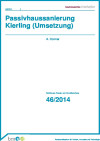
Schriftenreihe
46/2014
A. Donner
Herausgeber: BMVIT
Deutsch, 72 Seiten
Downloads zur Publikation
Demoobjekt energieautarke Solarfabrik
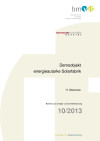
Schriftenreihe
10/2013
H. Gösweiner
Herausgeber: BMVIT
Deutsch, 34 Seiten
Downloads zur Publikation
Krankenhaus der Zukunft
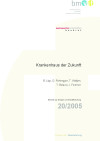
Schriftenreihe
20/2005
B. Lipp, G. Rohregger, T. Waltjen, T. Belazzi, J. Fechner
Deutsch, 174 Seiten
Downloads zur Publikation
PV Power Update
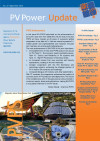
Herausgeber: IEA-PVPS
Englisch, 8 Seiten
Downloads zur Publikation
S-House

3/2005
Herausgeber: BMVIT
Deutsch, 6 Seiten
Downloads zur Publikation
Weiterentwicklung einer Optimierungsmethode
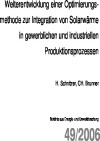
Schriftenreihe
49/2006
H. Schnitzer, Ch. Brunner
Deutsch, 90 Seiten
Downloads zur Publikation
Energieautarker Bezirk Güssing

Schriftenreihe
82/2006
R. Koch et al.
Herausgeber: BMVIT
Deutsch, 181 Seiten
